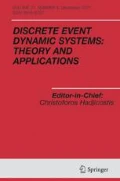Abstract
We present a survey of traffic models for communication networks whose key performance indicators like blocking probability and mean delay are independent of all traffic characteristics beyond the traffic intensity. This insensitivity property, which follows from that of the underlying queuing networks, is key to the derivation of simple and robust engineering rules like the Erlang formula in telephone networks.
Similar content being viewed by others
References
Ben Fredj S, Bonald T, Proutière A, Régnié G, Roberts JW (2001) Statistical bandwidth sharing: a study of congestion at flow level. In: Proceedings of ACM SIGCOMM, San Diego, 27–31 August 2001
Berger AW, Kogan Y (2000) Dimensioning bandwidth for elastic traffic in high-speed data networks. IEEE/ACM Trans Netw 8-5:643–654
Bertsekas D, Gallager R (1987) Data networks. Prentice Hall, Englewood Cliffs
Bonald T (2006a) The Erlang model with non-Poisson call arrivals. In: Proceedings of ACM SIGMETRICS / IFIP performance, Saint-Malo, 26–30 June 2006
Bonald T (2006b) Throughput performance in networks with linear capacity constraints. In: Proceedings of CISS, Princeton University, Princeton, 22–24 March 2006
Bonald T, Massoulié L, Proutière A, Virtamo J (2006) A queueing analysis of max-min fairness, proportional fairness and balanced fairness. Queueing Syst 53:65–84
Bonald T, Proutière A (2002) Insensitivity in processor-sharing networks. Perform Eval 49:193–209
Bonald T, Virtamo J (2005) A recursive formula for multi-rate systems with elastic traffic. IEEE Commun Lett 9:753–755
Cohen JW (1957) The generalized Engset formula. Phillips Telecommun Rev 18:158–170
Delbrouck LEN (1983) On the steady state distribution in a service facility with different peakedness factors and capacity requirements. IEEE Trans Commun 11:1209–1211
Dziong Z, Roberts JW (1987) Congestion probabilities in a circuit-switched integrated services network. Perform Eval 7-4:267–284
Engset TO (1998) On the calculation of switches in an automatic telephone system. In: Myskja A, Espvik O (eds) Tore Olaus Engset: the man behind the formula. Tapir Academic Press, Trondheim (first appeared as an unpublished report in Norwegian)
Enomoto O, Miyamoto H (1973) An analysis of mixtures of multiple bandwidth traffic on time division switching networks. In: Proceedings of the 7th International Teletraffic Congress, Stockholm, 1973
Erlang AK (1948) Solution of some problems in the theory of probabilities of significance in automatic telephone exchanges. In: Brockmeyer E, Halstrom HL, Jensen A (eds) The life and works of A.K. Erlang. The Copenhagen Telephone Company, Copenhagen (first published in Danish)
Gimpelson LA (1965) Analysis of mixtures of wide and narrow-band traffic. IEEE Trans Commun Technol 13-3:258–266
Heyman DP, Lakshman TV, Neidhardt AL (1997) A new method for analysing feedback-based protocols with applications to engineering Web traffic over the Internet. In: Proceedings of ACM SIGMETRICS, Seattle, 15–18 June 1997
Hordijk A, van Dijk N (1982) Adjoint processes, job local balance and insensitivity of stochastic networks. In: Bulletin of the 44th session of the international statistical institute, vol 50. International Statistical Institute, Voorburg, pp 776–788
Kaufman JS (1981) Blocking in a shared resource environment. IEEE Trans Commun 29:1474–1481
Kelly FP (1979) Reversibility and stochastic networks. Wiley, New York
Kelly FP (1991) Loss networks. Ann Appl Probab 1:319–378
Kelly FP, Maulloo A, Tan D (1998) Rate control for communication networks: shadow prices, proportional fairness and stability. J Oper Res Soc 49:237–252
Massoulié L (2007) Structural properties of proportional fairness: stability and insensitivity. Ann Appl Probab 17-3:809–839
Massoulié L, Roberts JW (2000) Bandwidth sharing and admission control for elastic traffic. Telecommun Syst 15:185–201.
Roberts JW (1981) A service system with heterogeneous user requirement. In: Pujolle G (ed) Performance of data communications systems and their applications. North-Holland, Amsterdam, pp 423–431
Serfozo RF (1999) Introduction to stochastic networks. Springer, Berlin Heidelberg New York
Sevastyanov BA (1957) An ergodic theorem for Markov processes and its application to telephone systems with refusals. Theory Probab Appl 2:104–112
Stevens WR (1994) TCP/IP illustrated, vol 1: the protocols. Addison-Wesley, Reading
van Dijk NM (1988) On Jackson’s product form with “jump-over” blocking. Oper Res Lett 7:233–235
Whitt W (1985) Blocking when service is required from several facilities simultaneously. AT&T Technol 64-8:1807–1856
Whittle P (1985) Partial balance and insensitivity. J Appl Probab 22:168–176
Author information
Authors and Affiliations
Corresponding author
Rights and permissions
About this article
Cite this article
Bonald, T. Insensitive Traffic Models for Communication Networks. Discrete Event Dyn Syst 17, 405–421 (2007). https://doi.org/10.1007/s10626-007-0012-5
Received:
Accepted:
Published:
Issue Date:
DOI: https://doi.org/10.1007/s10626-007-0012-5




